Documentação Geral
Cockpit – Relatório de Manutenção de Crédito

Relatório de Manutenção de Crédito
Por Fernanda Almeida
>> Definição e Premissas:
O relatório de manutenção de crédito tem como objetivo demonstrar se a aquisição do produto tem direito ou não ao crédito do ICMS de acordo com a operação de saída.
As premissas utilizadas para parametrização do relatório são:
1 – Regras de entrada onde o indicador de crédito seja igual a 1 ou 2;
2 – Regras de saída com a UF de origem será igual à UF de destino dos cenários de entrada
A chave de busca será sempre a UF de origem da regra de saída e o produto.
Os critérios de pesquisa são:
Regras de entrada: natureza de operação igual a 120 ou 121 onde contenha as marcações de manutenção ou estorno de crédito e indicador de crédito igual a 1 ou 2;
Regras de saídas: UF de origem será a UF de destino da regra de entrada, considerando a natureza de operação igual a 121 e o CST da operação seja igual a 40 ou 41.
>> Rotina no cockpit:
Para utilizar esse relatório, deve-se habilitar no menu “Funcionalidades”.
A rotina para geração do relatório está disponível no cockpit:
- Mais Opções
- Exportar Regras
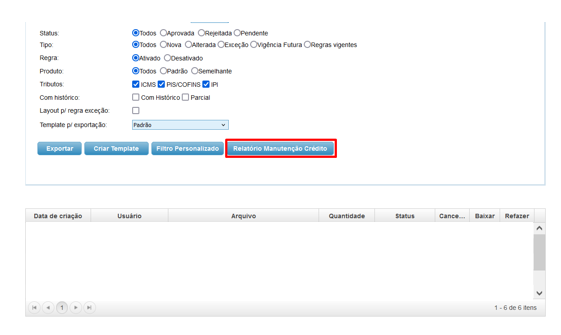
O usuário pode apenas clicar no botão  e será retornado no relatório a totalidade das regras que se encaixam no critério de pesquisa.
e será retornado no relatório a totalidade das regras que se encaixam no critério de pesquisa.
Também é possível fazer os filtros considerando a UF origem ou destino. Lembrando que a pesquisa por UF é para a operação de entrada. Caso seja necessário, também pode ser considerado os filtros por NCM ou código de produto.
Basta utilizar os filtros gerais da rotina de “Exportar Regras”:
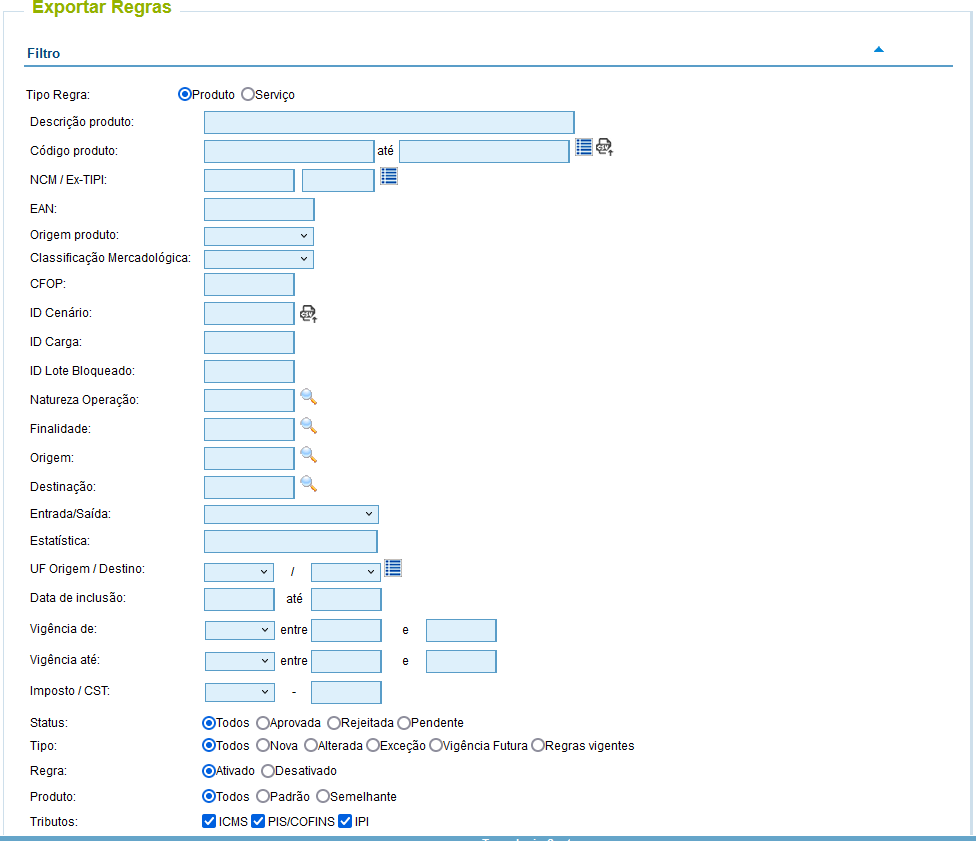
>> Layout do Relatório:
O relatório tem o seguinte layout:


É possível extrair o relatório em formato CSV ou EXCEL, basta selecionar a opção desejada no momento de nomear o relatório:
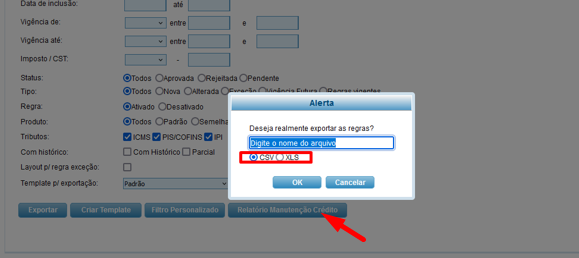
>> Conclusão:
Nos casos em que os clientes precisem de relatórios específicos para integração ou para conferência das nossas regras, é possível implementar o relatório contendo informações específicas das regras, conversão de informações, etc.
O relatório em questão é bem específico, porém pode ser utilizado por qualquer cliente que necessite fazer a verificação da tomada de crédito combinando a regra de entrada com a regra de saída.
Credit Maintenance Report
By Fernanda Almeida
>> Definition and Assumptions:
The credit maintenance report aims to demonstrate whether the product acquisition is entitled to ICMS credit according to the exit operation.
The assumptions used for report parameters are:
1 – Rules of entry operation where the credit indicator is equal to 1 or 2;
2 – Output rules with the Origin UF will be equal to the Destination UF of the entrance scenarios
The search key will always be the source UF of the output rule and the product.
The search criteria are:
Entrance rules: nature of the operation equal to 120 or 121 where it contains the maintenance markings or repayment of credit, and credit indicator equivalent to 1 or 2;
Exit Rules: The Origin UF will be the Destination UF of the entrance rule, considering the nature of the operation equal to 121, and the CST of the operation equal to 40 or 41.
>> Cockpit routine:
To use this report, you must enable it in the “Functionality” menu.
The report generation routine is available in the cockpit:
>> More Options
>> Export Rules
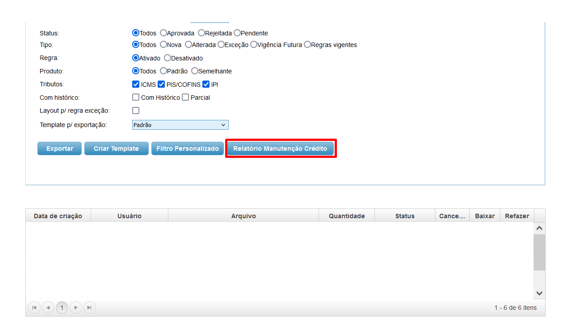
The user simply clicks on the button  and the report will return all the rules that fit the search criterion.
and the report will return all the rules that fit the search criterion.
It is also possible to apply filters considering the UF origin or destination. Remembering that the search by UF is for the entrance operation. If necessary, NCM or product code filters can also be considered.
Simply use the general filters of the “Export Rules” routine:
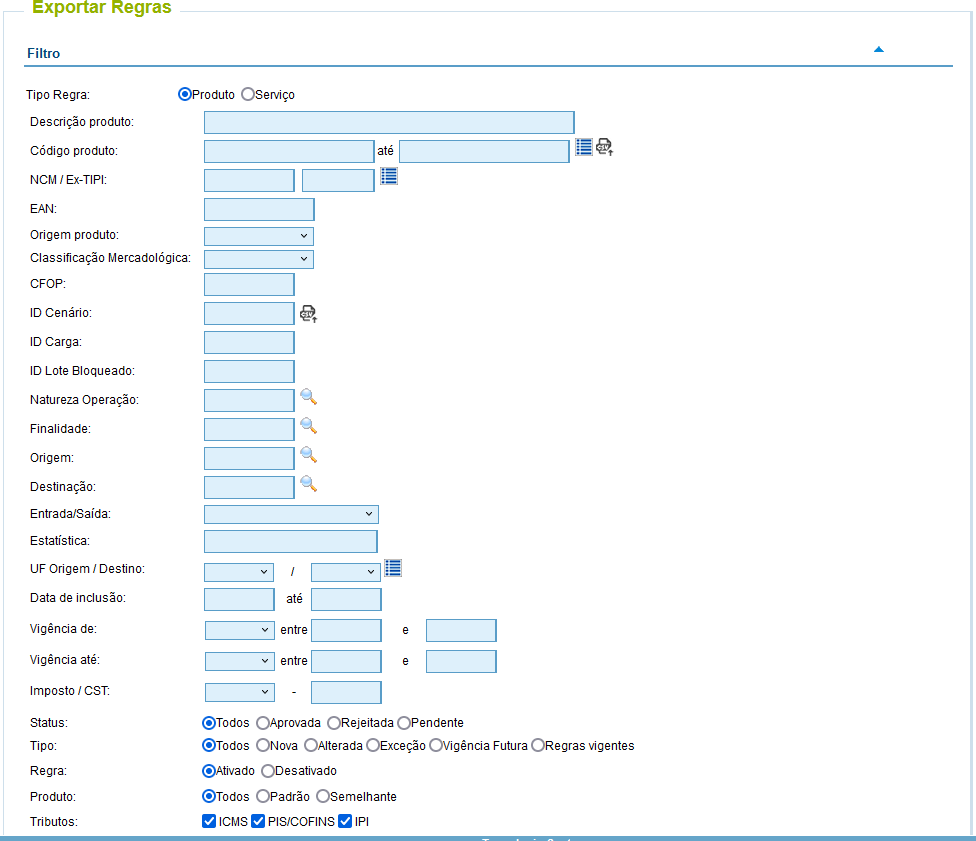
>> Report Layout
The report has the following layout:


You can extract the report in CSV or EXCEL format, just select the desired option when naming the report:
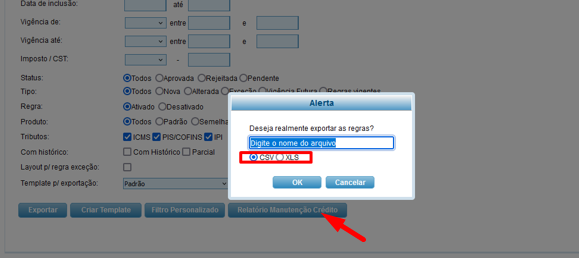
>> Conclusion:
In cases where customers need specific reports for integration or conference of our rules, it is possible to implement the report containing specific information of the rules, information conversion, etc.
The report in question is very specific, but it can be used by any customer who needs to do the credit check by combining the input rule with the output rule.
| Versão do documento: 67 | Publicação: 6/28/2024 |